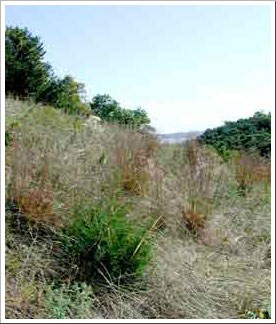|
What is a Prairie?
When European settlers came to North America, they encountered vast expanses of grass and wildflowers. They named these golden seas of remarkable beauty "prairies" for the French word for meadow. A prairie is a treeless landscape dominated by grasses and wildflowers (forbs). Complex and very productive ecosystems, the prairies of North America once covered a large portion of the continent, ranging from the Rocky Mountains in the west and continuing into Illinois and Indiana in the east, and extending from Canada in the north to Texas in the south. Today, less than 1% of the prairie remains, mostly in small patches. Restoration sites, steep river banks, roadsides and small pieces of land that were never cultivated are areas where prairie remnants are found today. Check out prairies in Minnesota. What Types are There?Three types of prairie exist in North America; short, mixed and tallgrass prairie. As the prairie moves from west to east, precipitation levels increase, and the prairie plants show a corresponding pattern of increased height.

Prairies need disturbances such as drought, fire and grazing to survive. They rely on these things to keep woody plants from invading the prairie and turning it into a forest. In pre-settlement times, enormous herds of grazers, such as bison, roamed the Plains, and their impacts helped to create the diversity that is essential to the prairie’s health. Grazers, through their browsing, wallowing (depressions where they lay), and fertilizing help to create a patchy landscape that promotes the growth of different kinds of plants. Drought is also important because prairie plants are much better adapted to survive dry conditions than trees, so droughts give the grasses and forbs a competitive advantage. Fire is extremely important in maintaining the health and diversity of the prairie while keeping the woody plants from establishing themselves. Before European settlers came to the Great Plains, fire was a relatively common phenomenon, coming both from natural sources such as lightening strikes, and from Native Americans. Native Americans used fire for a variety of reasons, including its use in controlling grazers. When a prairie is burned, the regrowth is very luxurious, so the bison would be attracted to it, and the Native Americans could have a better chance of hunting them. When settlers came, they realized that the tallgrass prairie has some of the most fertile soil in the world, and cultivated the land. As a result, much of the prairie became farmland. If an area was too wet or too dry to be cultivated, it was either overgrazed or became a woodland community due to the suppression of fire. Development of the fertile prairie lands into farmlands and later urban area has also hurt the prairie ecosystem. Another impact the settlers had on the prairie was the introduction of exotic species, which can often outcompete native species because they begin their growing season sooner in the year and they don’t have their natural competitors to keep their populations low. Exotic species are still a major problem for prairie restoration today. |
Prairie Restoration
|
Last updated: July 6, 2015
